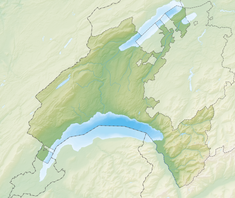
Lausanne is the capital and largest city of the Swiss French speaking canton of Vaud. It is a hilly city situated on the shores of Lake Geneva, about halfway between the Jura Mountains and the Alps, and facing the French town of Évian-les-Bains across the lake. Lausanne is located 62 kilometres northeast of Geneva, the nearest major city.

Vaud, more formally the canton of Vaud, is one of the 26 cantons forming the Swiss Confederation. It is composed of ten districts and its capital city is Lausanne. Its coat of arms bears the motto "Liberté et patrie" on a white-green bicolour.

Chexbres is a municipality in the Swiss canton of Vaud, located in the district of Lavaux-Oron. Chexbres is a wine-growing village and enjoys a good selection of local vintages. It also enjoys notable views of Lake Geneva, and therefore is nicknamed "Balcon du Léman" in French.

Saint-Saphorin is a municipality in the Swiss canton of Vaud, located on the shore of Lake Geneva, in the district of Lavaux-Oron.

Chillon Castle is an island castle located on Lake Geneva, south of Veytaux in the canton of Vaud. It is situated at the eastern end of the lake, on the narrow shore between Montreux and Villeneuve, which gives access to the Alpine valley of the Rhône. Chillon is amongst the most visited medieval castles in Switzerland and Europe. Successively occupied by the House of Savoy, then by the Bernese from 1536 until 1798, it now belongs to the State of Vaud and is classified as a Swiss Cultural Property of National Significance. The Fort de Chillon, its modern counterpart, is hidden in the steep side of the mountain.
Lavaux District was a district located on the north-eastern shore of Lake Geneva in the Swiss-romand canton of Vaud between Lausanne and Vevey. The capital of the district was Cully, but used to be Lutry. The district is part of the World Heritage Site listed region of Lavaux. It consisted of the following municipalities:

Lavaux is a region in the canton of Vaud in Switzerland, in the district of Lavaux-Oron. Lavaux consists of 830 hectares of terraced vineyards that stretch for about 30 km along the south-facing northern shores of Lake Geneva.
Lavaux-Oron District is a district in the canton of Vaud.

The Palais de Rumine is a late 19th-century building in Florentine Renaissance style in Lausanne, Switzerland.

Bourg-en-Lavaux is a municipality in the Swiss canton of Vaud, located in the district of Lavaux-Oron.

The Castle of Saint-Saphorin-sur-Morges, also called Mestral Castle, is a castle in the municipality of Echichens of the Canton of Vaud in Switzerland. It is a Swiss heritage site of national significance.
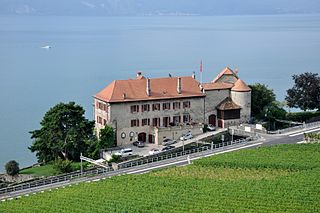
Glérolles Castle is situated in the municipality of Saint-Saphorin, canton of Vaud, Switzerland, on the northern shore of Lake Geneva. Its earliest elements date from a fortress built around 1150. The modern building serves as the headquarters for a vineyard of the same name, and as a venue which can be hired to host social events. It is a Swiss Cultural Property of Regional Significance.

The Swiss Reformed Church of Saint-Maurice, also named Church of Saint Marcel or simply the Chavornay Temple, is a Protestant church in the municipality of Chavornay, Vaud, Switzerland. It is a parish church of the Evangelical Reformed Church of the Canton of Vaud. It was listed as a heritage site of national significance.
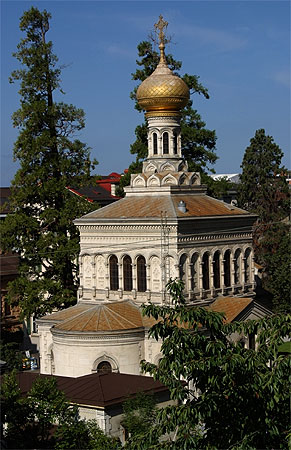
The Russian Orthodox Church, also called the Russian Orthodox Church of Saint Megalomartyr Barbara, is a Russian Orthodox Church in Vevey, canton of Vaud, Switzerland. It is listed as a heritage site of national significance.
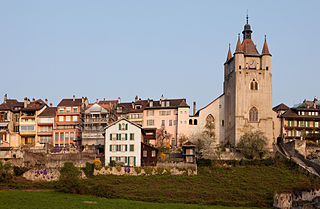
Orbe Temple, also known as the Reformed Church of Notre-Dame or the Great Church of Orbe, is a Protestant church in the municipality of Orbe, canton of Vaud, Switzerland. It is a parish church of the Evangelical Reformed Church of the Canton of Vaud. It is listed as a heritage site of national significance.
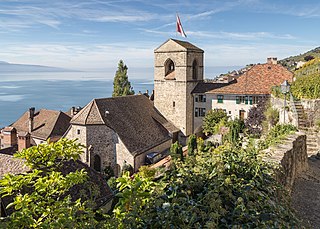
The Reformed Church of Saint-Symphorien is a Protestant church in Saint-Saphorin, canton of Vaud, Switzerland. It is listed as a heritage site of national significance.
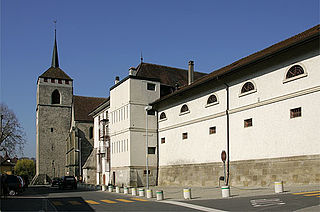
The Reformed Church of Saint-Étienne, also known as the Temple of Saint-Étienne, is a Protestant church located in the municipality of Moudon, canton of Vaud, Switzerland. It is a parish church of the Evangelical Reformed Church of the Canton of Vaud. It is listed as a heritage site of national significance.

Orbe-Boscéaz, also named Boscéay, is an archaeological site in Switzerland, located at the territory of the town of Orbe (Vaud).

The Church of St. Théodule is a Roman Catholic church located in Sion in the canton of Valais, Switzerland.

Michel Egloff was a Swiss prehistorian. He founded the Musée d'archéologie de Neuchâtel, which houses the archeological service of the Canton of Neuchâtel. He was chair of prehistoric archeology at the University of Neuchâtel, where he retired from in 2006 and became an honorary professor. He also founded the archeology museum Laténium in Hauterive.

